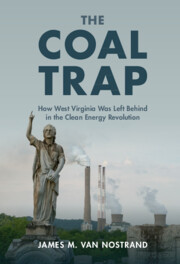Book contents
- The Coal Trap
- The Coal Trap
- Copyright page
- Dedication
- Contents
- Figures and Tables
- Introduction: “The Lost Decade”
- 1 The Rise of Environmental Regulations under Obama’s Environmental Protection Agency
- 2 The Shale Gas Revolution
- 3 The Rise of Renewable Energy
- 4 The “Ds” of Today’s Electric Utility Industry: Decarbonization and Decentralization
- 5 From “Friends of Coal” to the “War on Coal”: How West Virginia Went from Blue to Red
- 6 “Leadership” from Washington, DC: The Congressional Delegation That Could Have but Didn’t
- 7 Manchin in the Middle
- 8 The Failure of the Public Service Commission to Serve the Public
- 9 The Role of the Legislature in West Virginia’s Failed Energy Policies
- 10 Bailing Out the Coal Industry on the Backs of West Virginia’s Electric Ratepayers
- 11 Coal Operators Get Rich and West Virginia Gets to Clean Up the Mess
- 12 What the Future Could Hold if Leaders Choose to Lead
- Acknowledgments
- Index
8 - The Failure of the Public Service Commission to Serve the Public
Published online by Cambridge University Press: 07 July 2022
- The Coal Trap
- The Coal Trap
- Copyright page
- Dedication
- Contents
- Figures and Tables
- Introduction: “The Lost Decade”
- 1 The Rise of Environmental Regulations under Obama’s Environmental Protection Agency
- 2 The Shale Gas Revolution
- 3 The Rise of Renewable Energy
- 4 The “Ds” of Today’s Electric Utility Industry: Decarbonization and Decentralization
- 5 From “Friends of Coal” to the “War on Coal”: How West Virginia Went from Blue to Red
- 6 “Leadership” from Washington, DC: The Congressional Delegation That Could Have but Didn’t
- 7 Manchin in the Middle
- 8 The Failure of the Public Service Commission to Serve the Public
- 9 The Role of the Legislature in West Virginia’s Failed Energy Policies
- 10 Bailing Out the Coal Industry on the Backs of West Virginia’s Electric Ratepayers
- 11 Coal Operators Get Rich and West Virginia Gets to Clean Up the Mess
- 12 What the Future Could Hold if Leaders Choose to Lead
- Acknowledgments
- Index
Summary
Two energy policies in particular contributed to the disastrous results for ratepayers that became apparent at the end of “the lost decade.” First, there was the failure of energy utilities during most of that period to engage in long-term planning known as “least cost planning” or “integrated resource planning.” Integrated resource planning is a rigorous process that examines the full range of options – including both supply-side (generating resources) and demand-side (energy efficiency and conservation) – available to a utility to meet its resource needs at the lowest reasonable cost to its customers. Had integrated resource planning been in place prior to the “lost decade,” the risk associated with nearly exclusive reliance on coal-fired generation would have been apparent, and the massive rate increases that followed when coal prices soared could have been avoided. Moreover, the opportunity to diversify into natural gas-fired generation as the shale gas revolution was unfolding could have been thoroughly explored.
- Type
- Chapter
- Information
- The Coal TrapHow West Virginia Was Left Behind in the Clean Energy Revolution, pp. 165 - 194Publisher: Cambridge University PressPrint publication year: 2022



